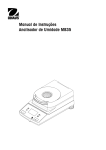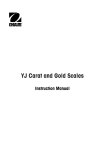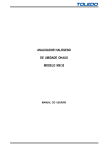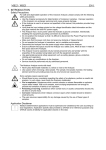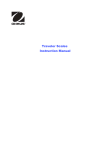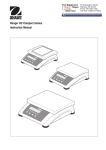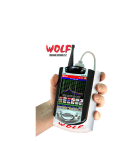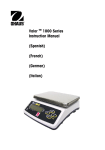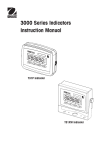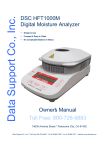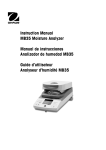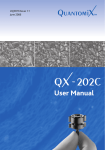Download User Manual - Affordable Scales & Balances
Transcript
Ohaus Corporation 19A Chapin Road P.O. Box 2033 Pine Brook, NJ 07058-2033 USA Instruction Manual MB35 Moisture Analyzer Manual de instrucciones Analizador de humedad MB35 Guide dutilisateur Analyseur dhumidité MB35 On P Men rint u / Off MB 35 H AL OG EN STA STO RT P TAR E Ohaus Corporation, 19A Chapin Road, P.O. Box 2033, Pine Brook, NJ, 07058-2033, USA Declaration of Conformity We, Ohaus Corporation, declare under our sole responsibility that the balance models listed below marked with CE - are in conformity with the directives and standards mentioned. Balance model (s) Moisture Analyzer MB35 Marked with: EC Directive (Including applicable amendments) Standard 73/23/EC Electrical equipment for use within specified voltage limits EN61010-1:1993 + A2: 1995 Safety requirements for Electrical Equipment for Measurement, Control Laboratory Use, Part 1: General Requirements 89/336/EC Electromagnetic compatibility EN61326:1997 (class B) EMC Emissions, residential, commercial and light industry. EN61326:1997 + A1:1998 (minimal requirements) EMC Immunity: Minimum test requirements. EN61000-3-2:1995 + A1:1998 + A2: 1998; EN61000-3-3:1995 EMC Part 3 (for equipment rated input current < or=16A) Limits- Section 2: Limits for harmonic current emissions Limits- section 3: Limitation of voltage fluctuations and flicker in low voltage supply systems Last two digits of the year in which the CE marking was affixed: 00 Additional Standards CAN/CSA-C22.2 No. 1010.1-92; UL Std. No. 3101-1 Safety requirements for Electrical Equip. for measurement, Control and Laboratory Use, Part 1; General Requirements FCC FCC, Part 15, class A Emission AS/NZS4251.1 AS/NZS4252.1 Emission and Immunity ISO 9001 Registration for Ohaus Corporation. Ohaus Corporation, USA, was examined and evaluated in 1994 by the Bureau Veritas Quality International, BVQI, and was awarded ISO 9001 registration. This certifies that Ohaus Corporation, USA, has a quality system that conforms with the international standards for quality management and quality assurance (ISO 9000 series). Repeat audits are carried out by BVQI at intervals to check that the quality system is operated in the proper manner. Ohaus Corporation, Pine Brook, NJn FCC NOTE: THIS EQUIPMENT HAS BEEN TESTED AND FOUND TO COMPLY WITH THE LIMITS FOR A CLASS A DIGITAL DEVICE, PURSUANT TO PART 15 OF THE FCC RULES. THESE LIMITS ARE DESIGNED TO PROVIDE REASONABLE PROTECTION AGAINST HARMFUL INTERFERENCE WHEN THE EQUIPMENT IS OPERATED IN A COMMERCIAL ENVIRONMENT. THIS EQUIPMENT GENERATES, USES, AND CAN RADIATE RADIO FREQUENCY ENERGY AND, IF NOT INSTALLED AND USED IN ACCORDANCE WITH THE INSTRUCTION MANUAL, MAY CAUSE HARMFUL INTERFERENCE TO RADIO COMMUNICATIONS. OPERATION OF THIS EQUIPMENT IN A RESIDENTIAL AREA IS LIKELY TO CAUSE HARMFUL INTERFERENCE IN WHICH CASE THE USER WILL BE REQUIRED TO CORRECT THE INTERFERENCE AT HIS OWN EXPENSE. Unauthorized changes or modifications to this equipment are not permitted. Contents 4 Contents 1. INTRODUCTION ................................................................................................................................ 5 1.1 Safety Precautions ............................................................................................................................. 5 2. INSTALLATION .................................................................................................................................. 7 2.1 Unpacking and Checking Equipment ................................................................................................... 7 2.2 Selecting the Location ........................................................................................................................ 7 2.3 Installing the Heat Shield, Draft Shield and Pan Support ......................................................................... 7 2.4 Connecting to a Power Supply ............................................................................................................ 8 2.5 Operating Controls ............................................................................................................................. 9 3. MOISTURE ANALYZER SETUP .......................................................................................................... 10 3.1 Language Setting ............................................................................................................................ 10 3.2 Weight Calibration ........................................................................................................................... 11 3.3 Temperature Calibration ................................................................................................................... 12 3.4 Time and Date Setting ...................................................................................................................... 13 3.5 RS232 Settings ............................................................................................................................... 14 3.6 Setting Print and GLP Printing On or Off ............................................................................................. 16 4. OPERATING YOUR MOISTURE ANALYZER .......................................................................................... 17 4.1 Setting the Drying Temperature .......................................................................................................... 17 4.2 Setting the Drying Time .................................................................................................................... 17 4.3 Sample Preparation ......................................................................................................................... 17 4.4 Running the Test ............................................................................................................................. 18 4.5 RS232 Command Table ................................................................................................................... 19 5. CARE AND MAINTENANCE ............................................................................................................... 20 5.1 Cleaning Interior/Exterior Components ................................................................................................ 20 5.2 Replacing Power Line Fuse ............................................................................................................... 21 5.3 Accessories .................................................................................................................................... 21 5.4 Specifications.................................................................................................................................. 22 Section 1 - Introduction 5 1. Introduction Thank you for deciding to purchase a MB35 Halogen Moisture Analyzer from Ohaus. Behind your instrument stands OHAUS, a leading manufacturer of precision Moisture Analyzers, Balances, Scales and Indicators. An Aftermarket Department with trained instrument technicians is dedicated to provide you with the fastest service possible in the event your instrument requires servicing. 1.1 Safety Precautions Your Moisture Analyzer employs state of the art technology and meets the latest demands regarding instrument safety. Improper operation can endanger personnel and can cause property damage. For safe and dependable operation, please comply with the following instructions: The Moisture Analyzer is used for determination of the moisture in samples. Please use the instrument exclusively for this purpose. Any other type of use can endanger personnel and damage the instrument or other property. The Moisture Analyzer must not be operated in a hazardous environment and only under ambient conditions specified in these instructions. The Moisture Analyzer may be operated only by trained personnel who are familiar with the properties of the samples used and with the handling of the instrument. Your Moisture Analyzer is supplied with a 3-pin power cable with an equipment grounding conductor. Only extension cables which meet the relevant standards and also have an equipment grounding conductor may be used. Intentional disconnection of the equipment grounding conductor is prohibited. The Halogen Moisture Analyzer works with heat! Ensure sufficient free space around the instrument to avoid heat accumulation and overheating (approximately 1 m free space above the instrument). Never place flammable materials on, below or next to the instrument as the area around the dryer unit warms up. Exercise caution when removing the sample. The sample itself, the sample chamber and any sample containers may still be very hot. During operation, you should never open the dryer unit as the ring-shaped heating element or its protective glass can reach 400°C! If you have to open the dryer unit on occasion, disconnect the instrument from the power supply and wait until the dryer unit has cooled down completely. Section 1 - Introduction 6 1.1 Safety Precautions (Cont.) Certain samples require special care! With certain types of samples, there is a possibility of danger to personnel or damage to property through: Fire or explosion: Flammable or explosive substances; Substances containing solvents; Substances which release flammable or explosive vapors when heated. With such samples, work at a drying temperature that is low enough to prevent the formation of flames or an explosion and wear protective goggles. Should there be any uncertainty regarding the flammability of a sample, always work with a small sample (maximum. 1 gram). In such cases, never leave the instrument unattended! In cases of doubt, perform a careful risk analysis. Poisoning, burning: Substances which contain toxic or caustic components. Such substances may be dried only in a fume hood. Corrosion: Substances which release corrosive vapors when heated (e.g. acids). In the case of such substances, we advise you to work with small amounts of samples as the vapor can condense on cooler housing parts and cause corrosion. Please note that the user always takes responsibility and assumes liability for damage caused by use of the types of samples mentioned above! Never make any modifications or constructional alterations to the instrument and use only original spare parts and optional equipment from Ohaus Corporation. Your Moisture Analyzer is a rugged, precision instrument but you should still treat it carefully; it will then provide you with many years of trouble-free operation. Please comply with all notes and instructions in these operating instructions. Keep the instructions in a safe place where they are immediately at hand if any points are unclear. If you lose these instructions, please contact your OHAUS dealer for an immediate replacement. APPLICATION DISCLAIMER: Moisture determination applications must be optimized and validated by the user according to local regulations. Application specific data provided by Ohaus is provided for reference purposes only. Ohaus waives all liability for applications based on this data. Section 2 - Installation 7 2. Installation This section contains unpacking and installation instructions for your new Moisture Analyzer . 2.1 Unpacking and Checking Equipment Open the package and remove the instrument and the accessories. Check the completeness of the delivery. The following accessories are part of the standard equipment of your new Moisture Analyzer. 1 Box, Aluminum sample pans 1 Pan support 1 Specimen sample (circular, absorbent cellulose disk) 1 Draft shield element 1 Heat shield 1 Power cable 1 Set of operating instructions 1 Warranty card Remove packing material from the instrument. Check the instrument for transport damage. Immediately inform your Ohaus dealer if you have complaints or parts are missing. Store all parts of the packaging. This packaging guarantees the best possible protection for the transport of your instrument. 2.2 Selecting the Location The Moisture Analyzer should always be used in an environment which is free from excessive air currents, corrosives, vibration, and temperature or humidity extremes. These factors will affect displayed weight readings. DO NOT install the Moisture Analyzer next to: On/Off Test Display Setup Menu MB 45 Open windows or doors or vents causing drafts or rapid temperature changes. Near vibrating, rotating or reciprocating equipment. START /STOP Enter Print TARE 2.3 Installing the Heat Shield, Draft Shield and Pan Support Install the heat shield, draft shield and pan support as shown. Turn the pan support until it engages In the locked position. PAN SUPPORT DRAFT SHIELD HEAT SHIELD Section 2 - Installation 8 2.4 Connecting to a Power Supply Check to ensure the voltage identification label on the Moisture Analyzer matches your local line voltage. The halogen dryer unit is designed to operate at a specific line voltage (120 V ac or 240 V ac). CAUTION: Connection to line voltages that are above or below the rated voltage can cause improper operation or damage to the unit. Connect power cord as shown. The MB35 is operational when power is applied. The display remains off until the On/Off button is pressed. Allow the Moisture Analyzer to warm up for at least 30 minutes to stabilize when turned on. WARNING: If the power cable supplied is not long enough, use only a proper 3-pin extension cable with an equipment grounding connector. Section 2 - Installation 9 2.5 Operating Controls The MB35 Moisture Analyzer controls are grouped as operating buttons and function buttons with three modes of operation. EDIT MODE - The user is changing a parameter, no test running. RUN MODE - The unit is in process of running a test. MB35 HALOGEN On / Off Print Menu RESULT MODE - Final result. START STOP MB35 Panel Controls OPERATING BUTTONS On/Off START STOP TARE TARE Turns display on and off. Starts the drying process (Run Mode). Ends drying process (Enters Stop Mode). Tares the balance. (Enters Run Mode). Accepts selection in Edit Mode. Ends Result Mode. FUNCTION BUTTONS 100 ° EDIT MODE ONLY CLEAR PAN PRESS TARE 10:00 0.000 g * 100 ° EDIT MODE ONLY CLEAR PAN PRESS TARE 10:00 0.000 g * ANALYZER SETUP EDIT MODE WEIGHT CAL TEMP CAL TIME-DATE RS232 PRINT EXIT Initial press of button highlights tempera- ture numerals. Additional presses increases temperature setting in 5 degree increments. Initial press of button highlights shut-off selection. Additional presses steps through options, AUTO or TIMED (Minutes/seconds). In a non-run mode, initial press of brings up the ANALYZER SETUP screen. button Section 3 - Analyzer Setup 10 3. Moisture Analyzer Setup 3.1 Language Setting For convienence, the Moisture Analyzer is equipped with several different languages available on all displays. This procedure permits the selection of any one language. 1. START ANALYZER SETUP WEIGHT CAL TEMP CAL TIME-DATE RS-232 PRINT EXIT 2. SELECT ANALYZER SETUP TEMP CAL TIME-DATE RS-232 PRINT EXIT LANGUAGE x6 LANGUAGE LANGUAGE SELECT LANGUAGE SELECT LANGUAGE ENGLISH ESPANOL TARE 3. ACCEPT/REJECT LANGUAGE CHANGE ALL TEXT TO ESPANOL TARE 4. FINAL ARE YOU SURE LANGUAGE ANALYZER WILL BE RESET TARE or NO 100 ° LIMPIE PLATLLO PULSE TARE 10:00 * 0.000 g Section 3 - Analyzer Setup 11 3.2 Weight Calibration 1. ANALYZER SETUP WEIGHT CAL TEMP CAL TIME-DATE RS-232 PRINT EXIT 2. TO START WEIGHT CAL 20g PLACE 20.0G MASS TARE 3. TO ABORT START STOP 4. TO CONTINUE TO ABORT PRESS STRT/STP KEY ANALYZER SETUP WEIGHT CAL TEMP CAL TIME-DATE RS-232 PRINT EXIT WEIGHT CAL REMOVE MASS TO ABORT PRESS STRT/STP KEY 5. TO ABORT START STOP 6. TO SAVE ANALYZER SETUP WEIGHT CAL TEMP CAL TIME-DATE RS-232 PRINT EXIT WEIGHT CAL ANALYZER SETUP PRESS TARE CAL SUCCESSFUL TARE TO ABORT PRESS STRT/STP KEY WEIGHT CAL TEMP CAL TIME-DATE RS-232 PRINT EXIT Section 3 - Analyzer Setup 12 3.3 Temperature Calibration 1. TO START NOTE: Optional Temperature Calibration Kit is required. ANALYZER SETUP 2. PREPARATION ANALYZER SETUP x1 WEIGHT CAL TEMP CAL TIME-DATE RS-232 PRINT EXIT WEIGHT CAL TEMP CAL TIME-DATE RS-232 PRINT EXIT TEMP CAL TEMP CAL INSERT CAL FIXTURE REMOVE PAN SUPPORT TARE CLOSE COVER ABORT CALIBRATION ABORT CALIBRATION TEMP CAL CALIBRATION READY PRESS TARE/ACCEPT ABORT CALIBRATION 3. START CALIBRATION 100C TARE 4. TEMP CAL 100C TEMP CAL 100C CURRENT TEMP: TM TO CAL PNT: --- C 15:00 MIN 15 minute time lapse CURRENT TEMP: TM TO CAL PNT: 100 C 10:00 MIN ADJ CAL READING: 100 C ACCEPT NEW CAL ABORT CALIBRATION ADJ CAL READING: 100 C ACCEPT NEW CAL ABORT CALIBRATION AFTER 15 MINUTE TIME PERIOD or ADJUST TO THERMOMETER READING TEMP CAL 100C CURRENT TEMP: TM TO CAL PNT: TEMP CAL 100C 100 C 10:00 MIN ADJ CAL READING: 101 C ACCEPT NEW CAL ABORT CALIBRATION CURRENT TEMP: TM TO CAL PNT: TARE 100 C 09:23 MIN ADJ CAL READING: 101 C ACCEPT NEW CAL ABORT CALIBRATION Section 3 - Analyzer Setup 13 3.3 Temperature Calibration (Cont.) 5. START CALIBRATION 160C TARE 6. TEMP CAL 160C CURRENT TEMP: TM TO CAL PNT: 100 C 15:00 MIN TEMP CAL 160C 15 minute time lapse ADJ CAL READING: 160C ACCEPT NEW CAL ABORT CALIBRATION CURRENT TEMP: TM TO CAL PNT: 160 C 10:00 MIN ADJ CAL READING: 160C ACCEPT NEW CAL ABORT CALIBRATION AFTER 15 MINUTE TIME PERIOD or ADJUST TO THERMOMETER READING 7. ACCEPT CALIBRATION TEMP CAL 160C TEMP CAL 160C CURRENT TEMP: TM TO CAL PNT: 160 C 10:00 MIN ADJ CAL READING: 161 C ACCEPT NEW CAL ABORT CALIBRATION 8. FINISH CALIBRATION TARE CURRENT TEMP: TM TO CAL PNT: ANALYZER SETUP WEIGHT CAL TEMP CAL TIME-DATE RS-232 PRINT EXIT TARE 160 C 10:00 MIN ADJ CAL READING: 161 C ACCEPT NEW CAL ABORT CALIBRATION Open the cover, allow unit to cool, remove the calibration fixture, replace the pan support and pan. 3.4 Time and Date Setting 1. 2. TO START ANALYZER SETUP WEIGHT CAL TEMP CAL TIME-DATE RS-232 PRINT EXIT SET FORMAT TARE x2 TIME - DATE or FORMAT: MM/DD/YR SET DATE: 07/10/01 TIME FMT: 12HR SET TIME: 11:30 AM ANALYZER SETUP WEIGHT CAL TEMP CAL TIME-DATE RS-232 PRINT EXIT TIME - DATE FORMAT: DD.MM.YR SET DATE: 10. 07. 01 TIME FMT: 12HR SET TIME: 11:30 AM Section 3 - Analyzer Setup 14 3.4 Time and Date Setting (Cont.) 3. Exit Without Saving ANALYZER Only when setting data. WEIGHT CAL SETUP TEMP CAL TIME-DATE RS-232 PRINT EXIT 4. SET DATE TARE TIME - DATE FORMAT: MM/DD/YR SET DATE: 06 /01 /01 TIME FMT: 12HR SET TIME: 11:30 AM or TARE Repeat to complete date 5. SET FMT TIME - DATE FORMAT: MM/DD/YR SET DATE: 06/01/01 TIME FMT: 12HR SET TIME: 11:30 AM or TARE Select 12HR or 24HR 6. SET TIME TARE TIME - DATE FORMAT: MM/DD/YR SET DATE: 06/01/01 TIME FORMAT: 12HR SET TIME: 11 :30 AM or TARE Repeat for minutes and am/pm 7. ACCEPT & LEAVE TARE ANALYZER SETUP WEIGHT CAL TEMP CAL TIME-DATE RS-232 PRINT EXIT 3.5 RS232 Settings 1. TO START ANALYZER SETUP WEIGHT CAL TEMP CAL TIME-DATE RS-232 PRINT EXIT x3 ANALYZER SETUP WEIGHT CAL TEMP CAL TIME-DATE RS-232 PRINT EXIT Section 3 - Analyzer Setup 15 3.5 RS232 Settings (Cont.) 2. SET BAUD RATE TARE RS232 BAUD RATE: PARITY: DATA BITS: STOP BITS: HANDSHAKE: 9600 NONE 8 1 NONE or Default is 9600. 3. SET PARITY TARE RS232 BAUD RATE: PARITY: DATA BITS: STOP BITS: HANDSHAKE: 9600 NONE 7 1 NONE or Default is NONE. 4. SET DATA BITS TARE 5. SET STOP BITS TARE 6. SET HANDSHAKE TARE RS232 BAUD RATE: PARITY: DATA BITS: STOP BITS: HANDSHAKE: 9600 NONE 8 1 NONE or Default is 8. RS232 BAUD RATE: PARITY: DATA BITS: STOP BITS: HANDSHAKE: 9600 NONE 7 1 NONE or Default is 1. RS232 BAUD RATE: PARITY: DATA BITS: STOP BITS: HANDSHAKE: 9600 NONE 7 1 NONE or Default is NONE. 7. ACCEPT & LEAVE TARE ANALYZER SETUP WEIGHT CAL TEMP CAL TIME-DATE RS-232 PRINT EXIT Section 3 - Analyzer Setup 16 3.6 Setting Print and GLP Printing On or Off 1. TO START ANALYZER SETUP ANALYZER SETUP x4 WEIGHT CAL TEMP CAL TIME-DATE RS-232 PRINT EXIT WEIGHT CAL TEMP CAL TIME-DATE RS-232 PRINT EXIT 2. SET PRINT TARE PRINT PRINT: OFF GLP: PRINT INT: OFF OFF OFF or On or Off. 3. SET GLP TARE PRINT PRINT: OFF GLP: PRINT INT: OFF OFF OFF or On or Off. 4. SET PRINT INTERVAL TARE PRINT PRINT: OFF GLP: PRINT INT: OFF OFF OFF or Minutes or Seconds. 5. TO SAVE TARE ANALYZER SETUP WEIGHT CAL TEMP CAL TIME-DATE RS-232 PRINT EXIT 100 ° TARE Complete Setup CLEAR PAN PRESS TARE 10:00 * 0.000 g Section 4 - Operating Your Moisture Analyzer 17 4. Operating Your Moisture Analyzer Once the Moisture Analyzer parameters have been set, moisture determinations can be made very simply. There are three simple steps to perform: 1. Setting the drying temperature, 2. Setting the drying time and 3. Preparing the sample. 4.1 Setting the Drying Temperature 100 ° CLEAR PAN PRESS TARE 10:00 * 0.000g or TARE Set temperature from 50°C to 160°C. 4.2 Setting the Drying Time SELECT AUTO OR TIMED 100 ° 10:00 SAMPLE <.500G * 0.000g or TARE Select timed or auto. FLASHING TIME TIMED DRYING TARE 100 ° 07:30 SAMPLE <.500G * 0.000g or TARE Change time when flashing. 4.3 Sample Preparation Please keep in mind the importance of preparing your sample, the distribution of the sample on the weighing pan, the type of sample and the temperature range. Remember, the greater the number of uniform samples tested, the greater the accuracy of the results. Results of substances which form crusts (e.g. glucose syrup) or pasty substances (e.g. butter) can be consider ably improved by mixing with quartz sand. For pasty, fat containing and melting substances, use of a glass fiber filter is advantageous to increase the surface area of the sample. The use of a glass fiber filter can be useful for temperature-sensitive and skin forming substances. In this case, the sample to be dried is covered by the filter and thus receives a new surface. Section 4 - Operating Your Moisture Analyzer 18 4.3 Sample Preparation (Cont). Clear the pan, press the Tare button. Incorrect sample distribution Correct sample distribution Distribution Correct amount Homogenously distributed Piling Excessive amount 4.4 Running the Test 130 ° 05:00 Initial display. SAMPLE <.500G 0.000 g * 130 ° CLOSE COVER Place sample on pan. (See above for correct sample distribution) 05:00 1.300 g * 130 ° TEST READY PRESS START Start process. 05:00 1.300 g START STOP * 130 ° 130 °C 02:45 Sample during drying process. 05:00 29.60% * 0.915 G 130 ° TEST OVER... 05:00 05:00 29.60% * 0.915 G Test end. Section 4 - Operating Your Moisture Analyzer 19 4.5 RS232 Command Table Output Formats Data output can be initiated in one of three ways: 1) By pressing the Print button; 2) Using the Print Interval feature; 3) Sending a print command (P) from a computer. RS232 Commands All communication is accomplished using standard ASCII format. Only the characters shown in the following table are acknowledged by the Moisture Analyzer. Invalid command response "ES" error indicates the Moisture Analyzer has not recognized the command. Commands sent to the Moisture Analyzer must be terminated with a Line Feed or carriage return-line line feed (CRLF). Data output by the Moisture Analyzer is always terminated with a carriage return - line feed (CRLF). RS232 COMMAND TABLE Command Character Description V Print SR version Esc V Print S/N (unit ID) ? Print current mode. TIME Print Current Time. DATE Prints Current Date. P Print elapsed time and present reading. RS232 Pin out The following table illustrates the pin-out connections on the RS232 connector. 1 2 <3 -> 4&6 5 7 -> 8 <9 N/C Data Out (TXD) Data In (RXD) Pins 4 and 6 are connected together. Ground Clear to send (CTS) Request To Send (RTS) N/C Section 5 - Care and Maintenance 20 5. Care and Maintenance In this section, you will learn how to keep your Moisture Analyzer in good condition and how to replace expendable parts. 5.1 Cleaning Interior/Exterior Components To continue to obtain precise measurements, it is advisable to clean the interior components at regular intervals. Please note the following instructions for cleaning your instrument. Disconnect the instrument from the power supply before cleaning. Cleaning Temperature Sensor and Protective Glass PROTECTIVE GLASS Check the protective glass and the temperature sensor for debris which could impede the operation. If the glass appears dirty, clean the surface facing the compartment using a commercial glass cleaner. If the sensor is dirty, clean using a mild cleaning agent. TEMPERATURE SENSOR Removing Glass for Cleaning If the inside of the glass is dirty, open the cover and remove the four cover screws as shown. Remove the glass holder and glass from the cover and clean with a commercial glass cleaner on both sides. Reassemble after cleaning. Section 5 - Care and Maintenance 21 5.2 Replacing Power Line Fuse If the instrument display fails to light after switching it on, check the power outlet first. If power is available, and the instrument fails to operate, the power fuse may be open (blown). Disconnect the instrument from the power supply before changing the fuse. Using a screwdriver, turn the fuse holder to the left (counterclockwise) and remove the fuse. Check the condition of the fuse. Replace blown fuse by those of the same type with the same rated value (5 x 20 mm, T6.3H 250 V). NOTE: If the fuse is good and power is available at the outlet, the cord or instrument may be defective. Try a new cord. If this does not work, the instrument should be sent back for servicing. The use of a fuse of a different type or with a different value as well as bridging or shunting the fuse is not allowed and can possibly cause a hazard to your safety and lead to instrument damage! 5.3 Accessories Description Span Calibration Mass 20 g ASTM Class 1 Tolerance Security Locking Cable RS232 Interface Cable, 9 pin serial extension - PC to MB45 RS232 Interface Cable, MB35 to printer (25 pin) SF42 Data Printer Sample Pans 90mm diameter Glass Fiber Pads Pan, Re-usable - 90mm (set of three) In-use Cover Temperature Calibration Kit Pan Handler Ohaus Part No. 49024-11 470004-010 80500525 80500571 SF42 80850086 80850087 80850088 80850085 11113857 11113873 Section 5 - Care and Maintenance 22 5.4 Specifications MODEL MB35 Capacity Readability Temp. Settings Drying Programs Switch-off Criteria Heat Source Calibration Dimensions (DxWxH) (in/cm) Pan Size Weight (lb/kg) Shipping Weight (lb/kg) 35g 0.005g, 0.05% 50°C to 160°C (5° increments) Standard Timed, Auto Halogen External calibration mass-20g 14 x 7.5 x 6/ 35.5 x 19 x 15.2 90 mm. diameter 9.8 / 4.5 14.1 / 6.4 Admissible ambient conditions Temperature range: Atmospheric humidity: Warm-up time: Voltage fluctuations: Installation category: Pollution degree: Power load: Current consumption: Power supply voltage: Power line fuse: Use only in closed rooms 5 ºC to 40 ºC 80% rh @ to 30 ºC At least 60 minutes after connecting the instrument to the power supply; when switched on from standby-mode, the instrument is ready for operation immediately. 15% +10% II 2 Max. 450 W during drying process 4 A or 2 A, according to the heating element 100 V 120 V or 200 V 240 V, 50/60 Hz (the voltage is given by the heating element) 1 piece, 5 x 20 mm, T6,3 H 250 V LIMITED WARRANTY Ohaus products are warranted against defects in materials and workmanship from the date of delivery through the duration of the warranty period. During the warranty period Ohaus will repair, or, at its option, replace any component(s) that proves to be defective at no charge, provided that the product is returned, freight prepaid, to Ohaus. This warranty does not apply if the product has been damaged by accident or misuse, exposed to radioactive or corrosive materials, has foreign material penetrating to the inside of the product, or as a result of service or modification by other than Ohaus. In lieu of a properly returned warranty registration card, the warranty period shall begin on the date of shipment to the authorized dealer. No other express or implied warranty is given by Ohaus Corporation. Ohaus Corporation shall not be liable for any consequential damages. As warranty legislation differs from state to state and country to country, please contact Ohaus or your local Ohaus dealer for further details. Ohaus Corporation 19A Chapin Road, P.O. Box 2033 Pine Brook, NJ 07058-2033, USA Tel: (973) 377-9000, Fax: (973) 593-0359 With offices worldwide. www.ohaus.com © Ohaus Corporation 2002, all rights reserved. P/N 80250903 A PRINTED IN SWITZERLAND
























